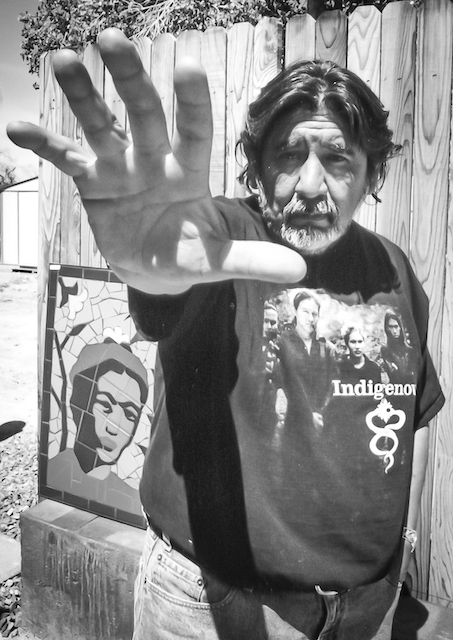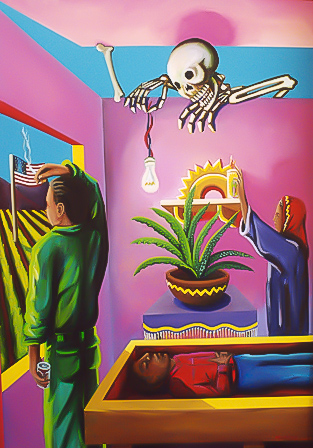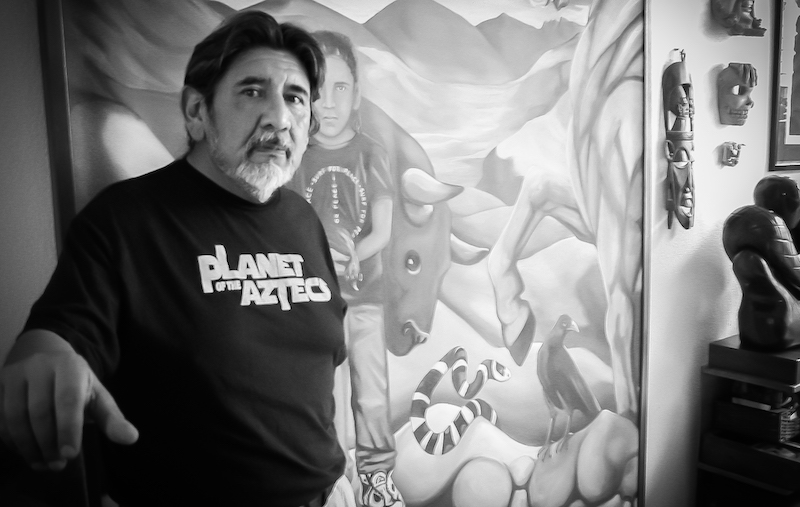This interview with Chicano artist Martin Moreno was conducted in May 2003 at his home in Laveen, Arizona. The interview presents only Moreno’s responses, formatted in a continuous narrative, without the inclusion of the questions.
“In order to understand my approach and philosophy to art, you need to understand my background. I was born in Michigan fifty-five years ago. When I was a child, I spoke Spanish only. The bilingual education system in my childhood days consisted of beatings. If you’re brought up in a Spanish-speaking family, and you’re educated in another system, conflicts automatically exist. You ask: ‘who’s right, who’s wrong?’ You grow up questioning why are things the way they are. You needed to quickly learn English, unless you enjoyed the beatings, so I became bilingual, and with that, there was an added responsibility: I became the family’s interpreter, and since I was able to articulate pretty well in both languages, I became involved in all the different struggles my family faced. I’ve always done art and drawn; I have always used my hands. The influence of my mother taught me that I could make anything with my hands, that everything was possible, and nothing was wasted, so you would use everything that was available to you.
“I graduated from high school at sixteen. That was the sixties decade, a time when there were a lot of changes in the country: the Vietnam War, Martin Luther King, the Kennedy’s, and all the tragedies that existed; the influence of drugs and flower power, the whole political consciousness, the movement of Chavez and the United Farm Workers. I became involved with all of that because I could articulate in English and Spanish. My relatives and I were all farm workers at one time; I worked with the UFW to help organize. By that time, I wanted to know a little bit more about the world that existed outside of my community, so I took off and went hitchhiking all over the country. This was right after my mother died, so I have been on my own since I was sixteen. I had to articulate my way out of jams and fights; when you are young, you never know what you can get into without thinking. When I was about seventeen, I ended up in Mexico City. There, I was exposed to the art, to the murals of the three Mexican masters: Orozco, Rivera, and Siqueiros. I saw the impact and the respect that these artists and their art were given. Having grown up in Detroit, I experienced and saw Rivera’s murals at the Detroit Institute of Art, and I was just overcome by them.
Related → Muralism today: still a catalyst for social change?
“In Mexico, I also saw the political and social implications of muralism. I stayed there for a whole summer, surviving on my drawings. I would draw and sell them to tourists. I thought: ‘Wow, how great, I am doing something I love, and people are liking it, this may be a possibility…’ I had never contemplated becoming an artist, because my whole focus was to work in the factories. You can point the finger and blame the family, the teachers or whoever, but that is unimportant; I found my creative gift back then, and saw that I could survive off of it. So the influence of the Mexican artists, and the issues that they deal with, their approach to it, was different than the public art in this country, where art is given a different treatment. We’re in a cultural vacuum here, where safety and pleasing the masses is what’s important, not the art itself. After that experience, I went back to Michigan, where I enrolled in College and started taking classes and developing my skills. By the time I was twenty, I started doing community organization, and I saw the potential of public art, in terms of dealing with social issues. I painted a three thousand dollar mural that ended up being 15-feet tall by 150-feet long; it was probably the best mural that that area had ever seen, in terms of the quality and purpose. The mural was a hit, so I started my own art school and continued to do murals in the summer all over a little city called Adrian. The reputation spread and I started doing exhibitions and sculptors, and basically surviving off the murals.

“I’ve been a director of a substance abuse program, and also a tutor and a counselor, but art has been an intricate part of that whole process, incorporating art in social issues, education, confidence building, and all the things that are missing in the traditional education systems. I’d incorporate that, especially for the youth, because of that cultural vacuum. When I was growing up, I had no idea that I had such a rich culture. Culture is not just beans and tacos and all that; we have a richness and a history that is not included in the history books, and not taught by teachers, because teachers teach what they are taught, and that void comes from the colleges and all the way down, so the cultural void is based on that educational ignorance. The only thing young people look at are ‘low-rider’ magazines, because that’s the only thing that is published out there for them, and that is the only thing they see as legit; and that’s because the art history books are not inclusive of their culture. I am really proud to say that when I do the murals, I am inclusive of my community. That ensures the longevity of the pieces; they don’t get tagged or vandalized.
“There are two avenues that I use. There’s an art that I create for the public, where you have to be considerate of your audience. When I first came to Phoenix eighteen years ago, I started doing a number of strong murals with messages about substance abuse, education, and so forth. These were some of the most powerful pieces that had ever been done in this area. From there, I got a reputation that the substance in my work was more than just aesthetically-pleasing, more than just visually well done, but that there was more to it, that it had spirit. Public art is different than the personal art. When you do personal art, you do it to satisfy an artistic need, but I’ve always said that an artist could make a living here easily doing the ‘pretty stuff’; if you do the saguaros, the coyotes in the mountains, cowboy and Indian stuff, because this area is culturally deprived, and that’s what they perceive art to be. But as an artist, I need to do more than that, so a lot of the issues I deal with are about my culture, my community, my existence, my observations, to give people a voice, and to point the finger if necessary. Those are the reasons I do the artwork
“If you study history, and look at the conflicts that have existed between countries, the first thing to be exchanged between those nations, after the conflict ends, is a cultural exchange through the visual arts, the performing arts, the music, poetry, etc. We should understand from history the importance of art, and how it can really change and bridge those gaps that exist between people. I think the arts should be inclusive in all aspects of our existence. Regardless if you are rich or poor, art is important for everyone, and a necessary element of a healthy community. Art gives people a voice, a legitimacy that ‘I am somebody,’ ‘I do have thoughts,” “I do have feelings,” and “I do have appreciation for beauty, aesthetics, and art.’

“I don’t care how much people say that we leveled the field, the field is not leveled yet. I still hear people being referred to as ‘wetbacks,’ ‘greasers,’ ‘taco benders,’ and all those labels that have been put upon us. I still see that our dropout rate is the highest in the nation, and as long as those issues aren’t addressed, if the artist doesn’t do it, then who will? If the artist doesn’t point the finger, then who will? I believe it is the right of the artist to do so, but also a responsibility. An artist can do it, and get away with it. If we sell our artwork in the process, that is coincidental, not the main reason you create. You make the statements because they have to be made. Whether it is through the written word, visual imagery, or cinema, one has to go beyond the commercial success, and make the statements necessary. Even though we all have artistic needs, the title of artist is one that has to be earned, not something that should be taken lightly, because it is a strong responsibility. I think ‘artist’ is a word that is thrown around too casually, so I leave it up to the people to give me that title.”
© 2003 - 2025, Eduardo Barraza. All rights reserved.





